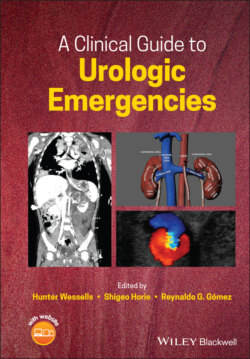Читать книгу A Clinical Guide to Urologic Emergencies - Группа авторов - Страница 11
ОглавлениеPreface
A Clinical Guide to Urologic Emergencies
The burden of urological disease worldwide is driven by a range of common conditions, some of which impair health acutely and others through chronic pathophysiological processes. Urological emergencies, when untreated, can lead to death, permanent disability, and lifelong reductions in quality of life. History is replete with examples including urinary stone disease in ancient Egypt and descriptions of combat wounds by Ambrose Pare in the Renaissance; this book will highlight common indications for acute urological intervention as well the emergence of unforeseen mechanisms of injury such as necrotizing genital skin infections associated with the introduction of novel sodium‐glucose cotransporter 2 (SGLT2) inhibitors for diabetes and the contemporary battlefield injuries of such immense complexity as to require the re‐engineering of military care.
Variation in population demographics, access to care, workforce capacity, and technology have a profound effect on how a given segment of the population will experience illness. The Global Burden of Disease, a tool to quantify health loss from hundreds of diseases, injuries, and risk factors, demonstrates that the determinants of health vary greatly by geography, whether continent‐, country‐, or county‐level. These disparities have been brought into sharper focus by the pandemic of COVID‐19, which exerts a disproportionate impact on individuals from minority populations in the United States and worldwide. These same at‐risk populations also shoulder an excess burden of disease due to war, cyclic violence, road traffic injuries, and diseases for which access to emergency care is essential.
Population growth worldwide, changing epidemiology of disease, and human migration and displacement will exacerbate emergency urological needs across the lifespan and across the spectrum of global wealth. For healthcare providers in high income countries (HIC), motor vehicle collisions, obstructing urinary calculi, urinary tract infections (UTI), and the cumulative burden of urological diseases associated with aging and comorbid chronic disease such as diabetes and cardiovascular disease will drive urgent and emergent healthcare utilization. Urological surgery to improve health in low and middle‐income countries (LMIC) has a critical focus on the broader impact of road traffic accidents, urethral stricture, advanced benign prostatic obstruction and genitourinary infections. The Lancet Commission on Global Surgery achieved consensus that HIC actors should work in equal partnership with LMIC actors and should situate efforts to improve the delivery of surgical care within the broader health systems strengthening agenda.
The editors have collaborated to present a global perspective, encompassing a diversity of healthcare environments, patient populations, and authors to ensure that the content of this book will be relevant to the widest range of healthcare providers. Acknowledging that not all urological care can or should be delivered by urologists, we provide detailed information for first‐line providers in urgent care, emergency, and office‐based settings. Where indicated we call out alternative laboratory testing, imaging, and treatments for situations in which resources preclude the use of technology intensive and costly choices. Similarly, the publisher has aimed to provide a low‐cost textbook with digital imprint to ensure wide accessibility.
We organized the content by organ systems, allowing the reader to go from “top to bottom” of the genitourinary system, or cut to the chase and find a specific chapter as a point of reference. An important feature incorporates perspectives on traumatic injuries from the civilian and military environments. Unfortunately, war and road traffic will place increasing burdens on civilian populations and healthcare systems. Thus, the inclusion of military and civilian perspectives allows for innovation, cross pollination, and preparedness. The burden of congenital anomalies cannot be eradicated and will require surgical and non‐surgical interventions across decades of a person’s life; early treatment can have enormous benefit and thus we include a chapter on neonatal emergencies.
Completing this book in the midst of a global pandemic, it is important to recognize that diagnosis and treatment of many urological conditions will be deferred because of limited access to routine care, surgery, and even emergency services. The frequency of extreme weather events, resource scarcity, and other factors will likely lead to other severe disease outbreaks that will further limit access to care and drive greater pressure on emergency urological services. Thus, it is instructive to estimate the burden of the COVID‐19 toll of deferred urological problems, which will come to the fore as pressure eases on ICU and Emergency Departments worldwide. We have added a special chapter on the topic.
References
1 http://www.healthdata.org/gbd/about
2 Ng‐Kamstra JS, Greenberg SLM, Abdullah F, et al. Global Surgery 2030: a roadmap for high income country actors. BMJ Glob Health. 2016; 1(1): e000011.
3 https://www.brookings.edu/research/the‐climate‐crisis‐migration‐and‐refugees/
